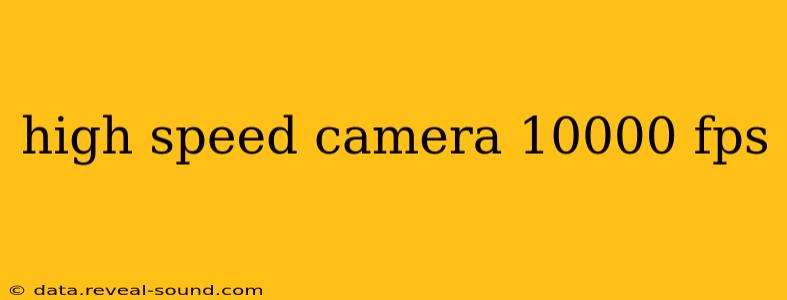High-speed cameras capable of capturing 10,000 frames per second (fps) and beyond have revolutionized various fields, offering unprecedented insights into incredibly fast-moving events. From scientific research to industrial quality control, these cameras provide a level of detail previously unimaginable. This article delves into the capabilities of 10,000 fps high-speed cameras, exploring their applications, key features, and the considerations involved in choosing the right one.
What Can You Film with a 10,000 FPS High-Speed Camera?
At 10,000 frames per second, you're capturing incredibly fine details of motion. Think about events that happen in the blink of an eye—a hummingbird's wingbeat, a bullet's trajectory, a droplet impacting a surface, or even the intricacies of a manufacturing process. These cameras allow you to slow down these events dramatically, revealing subtleties and allowing for thorough analysis. Applications range from:
- Scientific Research: Studying fluid dynamics, combustion processes, material deformation under stress, and biological processes like insect flight or animal locomotion.
- Industrial Quality Control: Identifying defects in manufacturing, analyzing the performance of machinery, and ensuring product reliability.
- Sports Analysis: Examining the mechanics of athletic movements, improving technique, and gaining a competitive edge.
- Automotive Testing: Analyzing crash tests, airbag deployment, and other safety-critical events.
- Military and Defense: Capturing high-speed events for analysis and training purposes.
- Film and Television: Creating visually stunning slow-motion sequences for artistic or documentary purposes.
What are the Key Features of a 10,000 FPS High-Speed Camera?
Several key features distinguish high-speed cameras operating at 10,000 fps from standard video cameras:
- High Frame Rates: The core feature is, of course, the ability to record at extremely high frame rates, often exceeding 10,000 fps.
- Resolution: While high frame rates are crucial, resolution also plays a significant role. Higher resolution allows for sharper detail and more accurate analysis of the captured events.
- Sensor Size: Larger sensors generally capture more light, resulting in better image quality, particularly in low-light conditions.
- Shutter Speed: Extremely short shutter speeds are necessary to freeze fast motion. The ability to adjust shutter speed is crucial for optimizing image clarity.
- Storage: High-speed cameras generate massive amounts of data, requiring robust storage solutions, often involving high-capacity SSDs or network-attached storage (NAS).
- Data Transfer: Efficient data transfer mechanisms are essential to manage the large volumes of data generated.
How Much Do 10,000 FPS High-Speed Cameras Cost?
The cost of a 10,000 fps high-speed camera varies greatly depending on the specific features and capabilities. Expect a significant investment, with prices ranging from several thousand dollars to well over one hundred thousand dollars for professional-grade models with superior resolution, frame rates, and other advanced features.
What are the Differences Between High-Speed Cameras and Regular Cameras?
The primary difference lies in the frame rate. Standard cameras typically capture between 24 and 60 fps, whereas high-speed cameras can reach thousands or even millions of fps. This allows for the capture and detailed analysis of incredibly fast phenomena invisible to the naked eye or standard cameras. High-speed cameras also often incorporate specialized sensors and image processing capabilities optimized for high-speed recording.
What are the Limitations of 10,000 FPS High-Speed Cameras?
While incredibly powerful, 10,000 fps high-speed cameras have limitations:
- Cost: As discussed earlier, these cameras represent a substantial investment.
- Lighting Requirements: High frame rates often require significant lighting to maintain sufficient image brightness.
- Storage and Data Management: The sheer volume of data generated requires careful consideration of storage and data management strategies.
- Processing Power: Analyzing the captured data requires significant processing power.
What is the Best High-Speed Camera for 10,000 FPS?
There's no single "best" camera, as the optimal choice depends on the specific application and budget. Researching various models from reputable manufacturers, considering their specifications, and reading user reviews are crucial steps in making an informed decision. Factors to consider include resolution, sensor size, frame rate capabilities at different resolutions, storage options, and ease of use.
This comprehensive overview provides a solid foundation for understanding the world of high-speed cameras capable of capturing 10,000 fps and beyond. Remember to carefully consider your specific needs and budget when making your selection.
